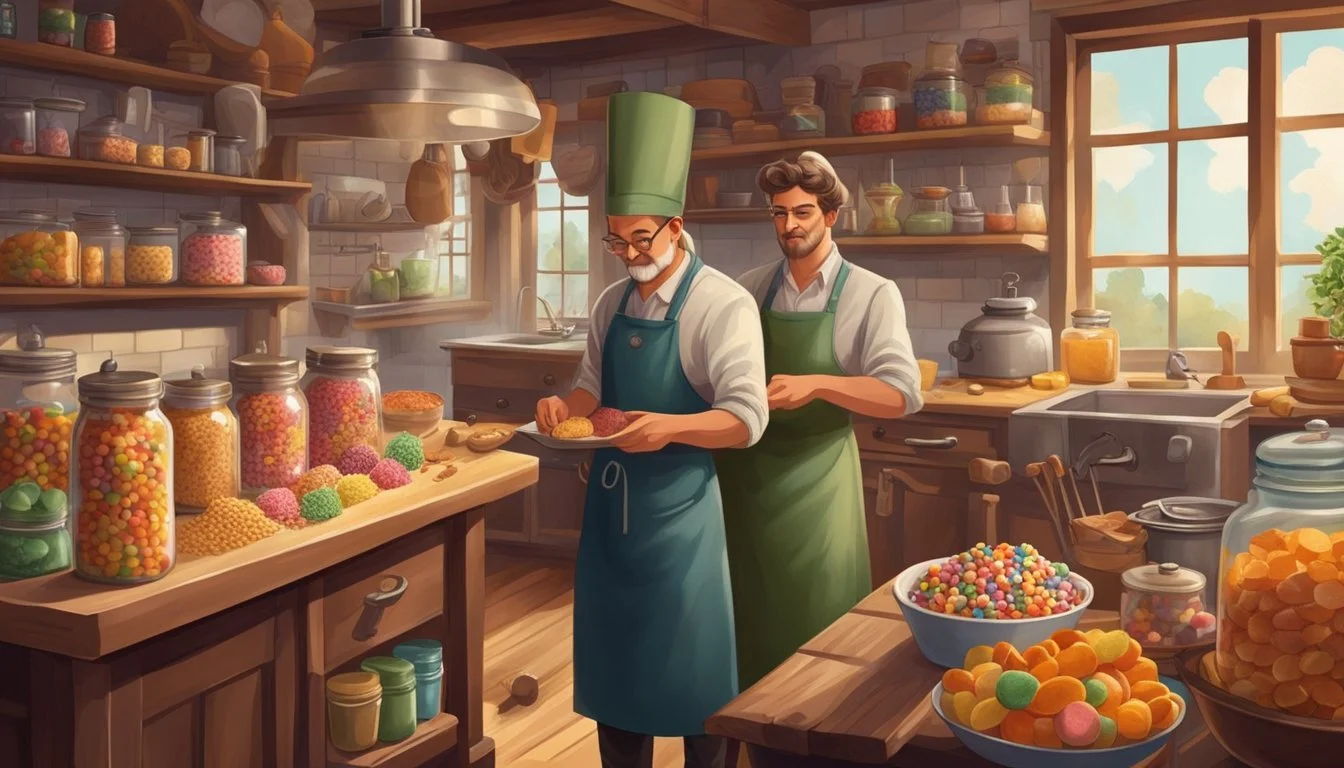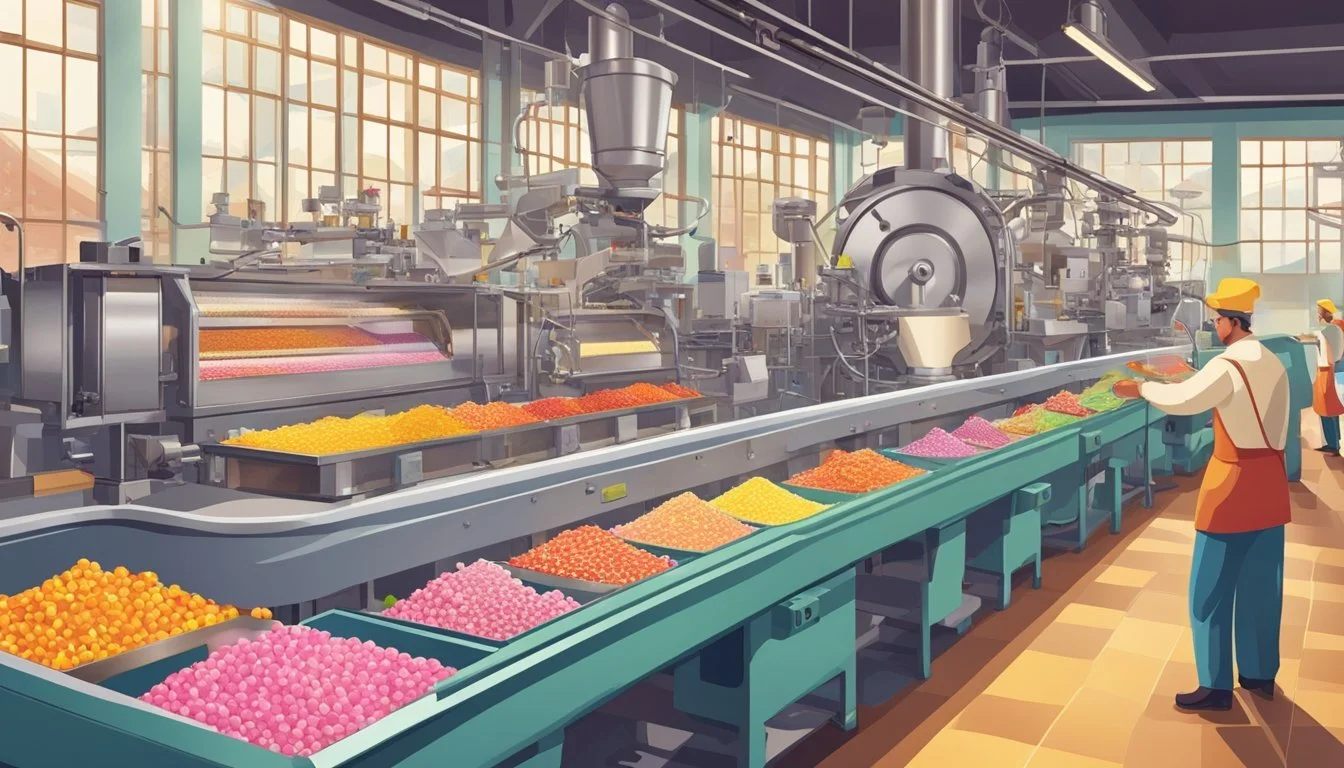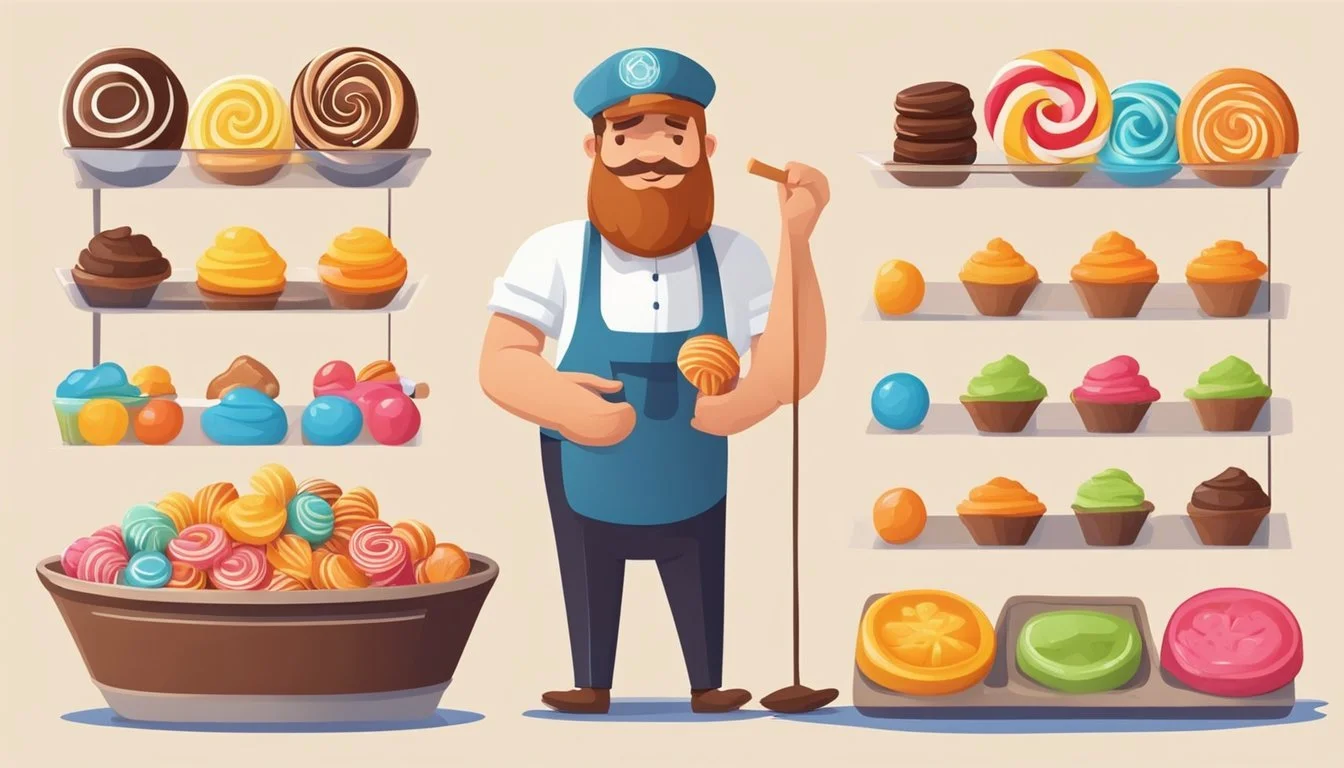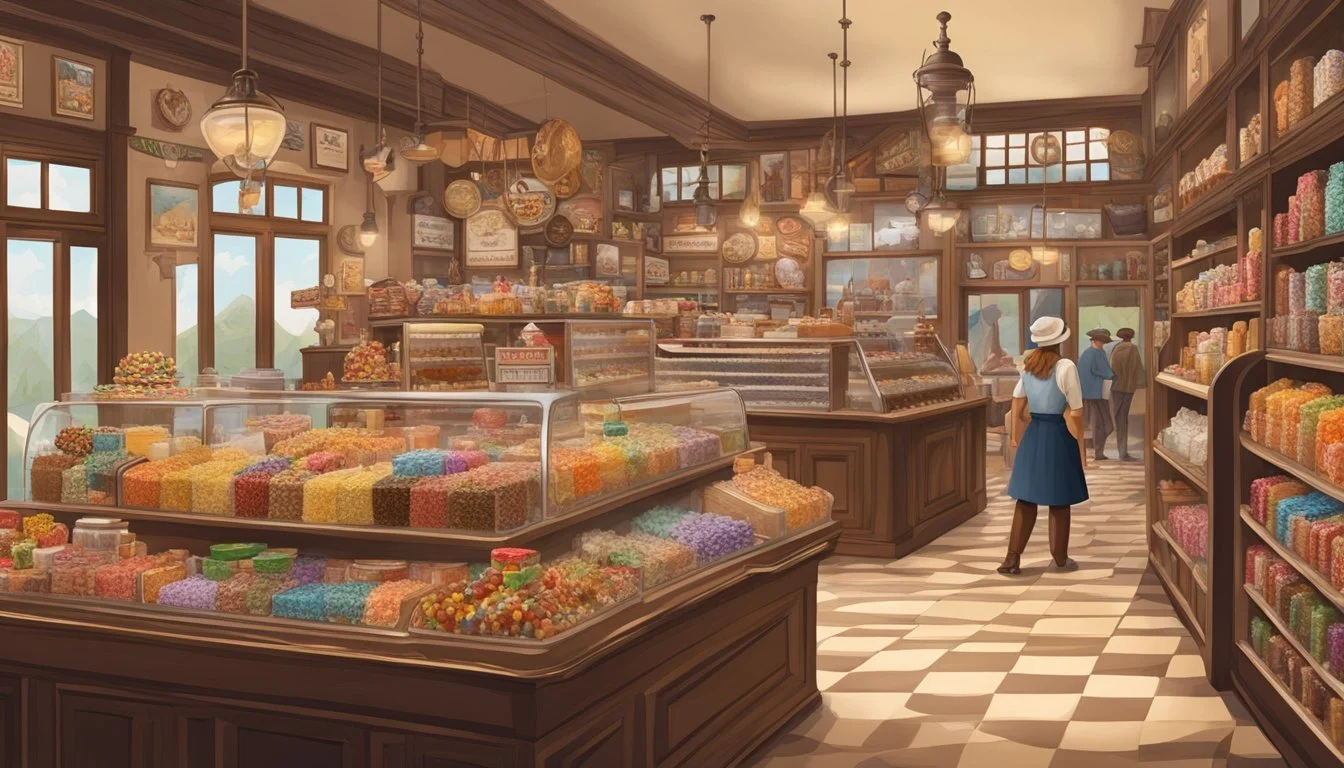The History of German Texan Candy Makers
A Sweet Legacy Unwrapped
The confectionery traditions of German Texans are as rich and varied as the history of the Lone Star State itself. These skilled candy makers and confectioners brought with them from Germany the meticulous craft of creating sweets, blending their time-honored techniques with local Texan ingredients. As early German immigrants established themselves in Texas, they infused their new communities with the flavors of their homeland, adapting and evolving their recipes to suit the tastes and resources of their adopted region.
Candy making in this community often harked back to recipes and methods passed down through generations. German Texan confectioners became known for their quality craftsmanship, and as their businesses grew, they played an instrumental role in shaping the local food culture. These artisans fashioned a variety of candies—from the simplicity of hard candies to the complexity of marzipan—an art form highly regarded in German confectionery.
While traditional German sweets such as marzipan were an important part of their repertoire, these confectioners were also innovative, creating unique confections that married their German skills with Texan flavors. Their commitment to quality and continuity established a confectionery heritage that continues to influence the state’s culinary landscape. With a community built on strong cultural retention, the legacy of German Texan candy makers remains an integral part of the region's identity.
Origins of German Texan Confectionery
The roots of German Texan confectionery intertwine with the waves of German immigration to Texas during the 19th century. Renowned for their confectionery skills, German immigrants brought the rich traditions of their homeland to the Lone Star State, blending local ingredients with their time-honored recipes.
Key Ingredients:
Nuts: Pecans were integrated into recipes for pralines and other nut-based treats.
Sugar: Access to local sugar allowed for a wide range of sweets.
Spices: Traditional German spices enriched the flavor profiles of confections.
Renowned German confectioners laid the foundation for a regional candy-making legacy by adapting their craft to available resources. A notable example is the introduction of the Mozartkugel by a confectioner named Paul Fürst, who named the chocolate (What wine goes well with chocolate?) after Mozart. While the original remained in Austria, its influence on German Texan confectionery is undeniable, with local adaptations emerging over time.
Local Adaptations:
German Chocolate Cake: While not a direct import, its namesake comes from an American baker named Samuel German, highlighting the intertwined history of confectionery in Texas and Germany.
Texas Pralines: Adapted to include native pecans, becoming a Texan staple.
These German Texans not only carried their own confectionery techniques but also incorporated regional tastes by using local nuts like pecans, spices, and sugar, creating a confluence of flavors that reflected both their German heritage and their new home in Texas.
Early German Texan Candy Makers and Their Techniques
German immigrants profoundly impacted the food industry in Texas, which included the niche of candy making. These early confectioners utilized their heritage techniques and recipes to introduce a unique variety of sweets to the local palate. Sugar, an essential component of candy, was a luxury in the early days, and German candy makers were adept at manipulating both sugar and molasses, the latter being a more affordable sweetener available to the masses.
The techniques they employed were often passed down through generations. They utilized a combination of hand-crafting and the rudimentary equipment available at the time, such as simple molds and hand-cranked rollers. This allowed them to produce candies with a personal touch that was evident in the final product's quality and taste.
Candy making in those times was an artful process, often involving the delicate temperature control of sugar solutions to craft hard candies, soft chewables, and delectable caramels. The German Texan candy makers were known for their precision in this process, carefully cooking sugar syrups to the perfect consistency before cooling and shaping them.
Ingredients:
Sugar
Molasses
Techniques:
Hand-crafting
Temperature control of sugar syrups
Use of molds and manual rollers
These confectioners played a pivotal role in community gatherings, often showcasing their creations at local markets and festivities. Their candies were not only treats for children but also savored by adults, reflecting the German love for quality confections. The legacy of these German Texan candy makers can still be felt today, with numerous family-owned candy shops in Texas tracing their roots back to these early artisans.
Popular German Texan Candy Varieties
German Texan confectioners have a long history of candy-making, resulting in a delightful assortment of sweets that combine the precision of German techniques with the bold flavors of the Lone Star State.
Hard Candies and Bonbons
Texas confectioners of German heritage excel in creating hard candies with a variety of flavors, from traditional fruit essences to spicy cinnamon bursts. Their craftsmanship is evident in the clarity and consistency of each candy, making them not only delicious but also visually appealing. Bonbons, too, represent a blend of cultures, offering creamy centers enrobed in a crisp sugar shell. Carrying on from old-world recipes, these treats have a special place on the Texan palate.
Flavor examples:
Apple Cinnamon
Citrus Spice
Chocolate and Truffles
The influence of German chocolatiers in Texas is undeniable, with their products showcasing the finesse of fine European chocolate-making. German Texan chocolatiers pay homage to their roots with rich, velvety chocolate experiences, extending from simple milk chocolate bars to complex truffles (What wine goes well with truffles?). These truffles often feature ganaches infused with local ingredients like pecans, bourbon, or mesquite.
Chocolate Varieties:
Dark Chocolate
Chocolate with Nuts
Marshmallows, Jellies, and Gums
Marshmallows crafted by German Texan candy makers are known for their light, airy texture and are often flavored with natural vanilla or fruit purees. Jellies feature local fruits, incorporating the ripe bounty of Texas orchards into chewy treats that burst with flavor. Gums, on the other hand, maintain a consistent chewiness and come in an assortment of shapes and flavors, from classic mint to more experimental tastes, such as sassafras or tamarind.
Jelly Flavors:
Peach
Raspberry
Blackberry
Seasonal and Special Occasion Candies
In the landscape of German Texan confectionery, seasonal and special occasion candies reflect a rich heritage blending German traditions with Texan flavors. These treats, reserved for specific holidays, showcase a variety of ingredients and are eagerly anticipated by both locals and visitors.
Christmas Delights
Stollen: This traditional German Christmas bread, rich with dried fruits, nuts, and spices, often finds its way into Texan festivities through the hands of German Texan bakers. Drizzled or dusted with icing sugar, it is a staple on Christmas tables.
Chocolate Advent Calendars: A countdown to Christmas with a sweet twist, these calendars commonly feature Texas-themed shapes and locally sourced chocolates.
Candy Canes: The candy cane, a peppermint-flavored treat, is a Christmas icon that adorns many a German Texan Christmas tree and fills gift baskets, combining traditional German flavors with the peppermint plant which thrives in Texan soil.
Easter Treats
Easter Eggs: In true German tradition, chocolate Easter eggs and marzipan treats are crafted by German Texans, often incorporating pecans and local honey, which are abundant in Texas.
Chocolate Bunnies: Another Easter staple, chocolate bunnies, sometimes feature a unique Texan twist, such as being filled with BBQ flavored pralines.
Halloween Specialties
Pumpkin Spice Chocolates: German Texan chocolatiers often create pumpkin-shaped chocolates infused with the seasonal flavors of pumpkin spice, melding the German love for confectionery with Texan autumnal harvests.
Halloween Candy Mixes: Local confectioners prepare mixes that include festive candy corn, frightfully shaped gummies, and chocolate ghosts, balancing traditional German craftsmanship with the fun and spooky spirit of an American Halloween.
Industrial Evolution and Mass Production
During the Industrial Revolution, German Texan candy makers seized new technological advancements to upscale their candy production. The introduction of machinery and equipment revolutionized the way candy was made, shifting from labor-intensive methods to automated processes.
Machinery: To mitigate the laborious task of candy making, German confectioners employed machines such as the candy press, which enabled the creation of multiple candy shapes and sizes simultaneously. This not only increased efficiency but also allowed for greater uniformity and variety in candy production.
Chewing Gum: A distinct contribution by German Texan confectioners was the commercial production of chewing gum. Utilizing industrial techniques, they transformed the traditional method of making chewing gum, leveraging mechanical systems for mass production and thus mainstreaming its availability.
Equipment: Innovations in cooking and cooling equipment were also pivotal. Steam-powered cooking devices improved the boiling of sugar, while mechanized cooling systems expedited the setting process of confections, thereby increasing the overall output of candy factories.
Advancements Impact on Candy Production Candy Press Standardized shapes and sizes, increased productivity Steam Pans Enhanced boiling methods, improved quality Cooling Systems Reduced setting time, greater volume of production
Candy production in the era of the Industrial Revolution for German Texan confectioners marked an era of significant growth and efficiency, ultimately laying the groundwork for the modern candy industry.
Influence of German Texan Confectioners in American Candy Industry
German Texan confectioners have played a significant role in shaping the American candy industry through their introduction of new flavors and innovative techniques, as well as their successful business practices that helped expand the market nationwide.
Introduction of New Flavors and Techniques
German immigrants in Texas and other parts of the United States brought with them a rich tradition of candy making that included a variety of unique flavors and confections previously unknown in America. They introduced sugarplums, marzipan, and a diverse range of pastries and sweets. German Texan artisans were skilled in techniques that allowed them to create high-quality candies that were both visually appealing and delicious. These practices soon influenced local candy makers, particularly in areas like Philadelphia, Pennsylvania, which was already a hub for the American candy industry.
One noteworthy German contribution was their expertise in working with chocolate, which was less common in the United States at the time. They utilized skills to craft fine chocolates, which they sold through local candy stores, setting a new standard for quality.
The Role of German Texan Business in Market Expansion
The success of German Texan confectioners was not limited to their craftsmanship but also included their business acumen. They established candy making as a significant industry through their entrepreneurial spirit, contributing to the broader American candy industry by expanding the market. Philadelphia, a city with a thriving German immigrant population, became a noted center for candy production. The large-scale manufacturing of candy here can be attributed partly to the influence of German techniques and traditions.
German Texan confectioners leveraged their knowledge of confectionery and their business practices to build successful enterprises. These businesses often started as small family-run candy stores but with time became influential companies that pushed the boundaries of candy production and distribution, enabling American candies to be enjoyed by a larger demographic.
Challenges in the German Texan Confectionery Trade
The German Texan confectionery trade has navigated a series of economic and competitive challenges that have shaped the industry. These issues include market fluctuations and the impact of industry consolidation.
Economic Fluctuations
German Texan candy makers faced the challenge of economic fluctuations which affected the price and availability of ingredients and materials. They had to navigate varying sugar and cocoa prices, which directly influenced their product costs and profit margins. Furthermore, the cost of equipment necessary for candy making, such as specialized machinery for chocolate tempering or candy cutting, often fluctuated, leading to unpredictability in operational expenses.
Consolidation and Competition
Throughout its history, the German Texan confectionery industry saw a trend towards consolidation, with larger entities acquiring smaller, family-run businesses. This led to fewer, but more powerful, players in the market. Meanwhile, competition remained fierce, not only among local confectioners but also with national brands entering the Texan market. These competitors often had access to more sophisticated equipment, allowing for mass production and, consequently, lower prices. Additionally, some companies suffered setbacks due to fire incidents, which compromised production and highlighted the importance of safety measures within their facilities.
Cultural and Social Impact of Candy Making in Texas
In Texas, German immigrants contributed significantly to the local confectionery landscape. Candy making evolved as a cherished craft within these communities. The creation of sweet treats became a symbol of the German Texan ability to blend cultural heritage with new opportunities.
Community gatherings often featured locally made candies, strengthening social bonds. Particularly during festivals, such as the annual Wurstfest in New Braunfels, confections sat alongside savory delicacies, highlighting the importance of balance in dietary consumption.
The introduction and popularity of candies such as Texas Pralines showcased a blend of German precision with the state’s abundant pecan crops. These decadent treats quickly found their way into the hearts of Texans, representing a cross-cultural appreciation for confectionery craftsmanship.
Consumption of such delicacies became a normal part of Texan life. Confectioners, many of German descent, tapped into a collective palate eager for both rich flavors and the comfort of communal heritage. This exchange, not merely commercial but also cultural, facilitated a unique identity for German Texans, who prided themselves on their contributions to the state's diverse foodways.
Sweet treats thus served as more than mere indulgence; they became a medium through which German Texans communicated their identity, history, and social values. As candy makers thrived, they helped shape a confectionery tradition that remains an integral thread in the fabric of Texas culture.
Prominent German Texan Candy Brands and Figures
The German Texan community has brought forth several important candy brands and figures in America's confectionery history. They transformed the sweets industry with innovation and quality that have become household names worldwide.
Stephen F. Whitman and The Whitman Sampler
The founder, Stephen F. Whitman, started his confectionery business in 1842 in Philadelphia. Although not directly a part of Texas history, his impact on American confectionery and his German heritage have made significant contributions to the industry at large. The Whitman Sampler, his most famous creation, became an iconic box of assorted chocolates, symbolizing variety and quality in one package. Whitman's vision and brand set a precedent that influenced generations of candy makers, including those in Texas.
Milton Hershey and The Hershey Company
Milton Snavely Hershey, with German lineage, was instrumental in popularizing chocolate. Starting with caramels, Hershey transitioned to chocolate, founding The Hershey Company in 1894. His innovative approach to chocolate-making and his mass-production techniques made this sweet treat accessible to the general public. The company became one of the largest in North America and spawned a town that bears its name. Hershey's legacy remains substantial, with his company standing as a giant in the confectionery industry.
Preservation of Traditional Candy Making
German Texan confectioners have been critical in preserving traditional candy-making methods, ensuring that historic flavors and techniques continue to be cherished and enjoyed. These artisans maintain original recipes and processes, such as handcrafting bonbons and caramels, working with local nuts, and perfecting marzipan creations.
Artisan Techniques and Heirloom Recipes
Craftsmen dedicated to the art of candy making employ a range of time-honored techniques to produce their sweets. Bonbons and caramels are meticulously handcrafted, following heirloom recipes that have been passed down through generations. The expertise required in temperature control and timing preserves the authentic taste and texture of these classic treats. Ingredients like regional nuts are sourced with care, ensuring a true representation of the traditional German Texan palate.
Key Techniques:
Temperature precision for sugar syrups
Hand-rolling and shaping of marzipan
Use of copper kettles for even heat distribution
Heirloom Ingredients:
Locally-sourced pecans and other nuts
High-quality cream and butter for rich caramels
Almond paste for authentic marzipan figures
These methods and ingredients culminate in confections that not only evoke nostalgia but also maintain high-quality standards.
Modern Revival of Historic German Texan Brands
Several historic German Texan brands have experienced a modern revival, bringing classic candies back into the limelight. These businesses adhere strictly to the original formulations, using recipes that have stayed unchanged for decades. By doing so, they honor the craftsmanship of their predecessors and provide customers with a genuine taste of history.
Brand Revitalizations:
Reintroduction of classic packaging designs
Renewed focus on small-batch production
Emphasis on artisanal, handcrafted methods
Whether producing delicate marzipan figures or robust nut-infused caramels, these brands strike a balance between traditional authenticity and contemporary appeal. The commitment to preserving time-honored confectionery practices is key in ensuring these sweet treasures continue to be part of German Texan culture.
Current Trends in German Texan Confectionery
As the confectionery scene in Texas continues to evolve, German Texan candy makers are blending traditional sweets with modern demands. They emphasize organic ingredients, and novel flavor combinations, catering to a more health-conscious and adventurous clientele.
Organic and Natural Sweet Treats
Today's consumers increasingly seek out organic confectionery options, and German Texan candy specialists have responded. They source locally-grown fruits and prioritize natural sweeteners, aiming to provide treats that satisfy the sweet tooth while being mindful of wellbeing. Artisans proudly create chocolates and candies adhering to organic certification standards, meticulously avoiding synthetic additives.
Examples of organic confectionery offerings include:
Handcrafted chocolate bars made with Texas pecans and organic, fair-trade cacao.
Candies featuring Texas-grown fruits, such as strawberries and peaches, with no artificial flavors or colors.
Innovations in Candy Flavors and Textures
Inventiveness is key to the German Texan confectioner's craft, particularly in the realm of candy flavors and textures. Artisans draw inspiration from both Texas's rich culinary culture and their German heritage to produce an array of innovative sweets. Distinctive combinations like jalapeño-infused chocolate or salted caramel pralines with a hint of beer showcase their ingenuity.
Highlights include:
A bold mix of sweet and spicy with chili-chocolate creations, marrying heat with the smoothness of chocolate.
Chewy candies blended with unexpected textures, such as the inclusion of toasted pecan pieces for a satisfying crunch.
By combining organic, natural ingredients with bold innovations in flavor and texture, German Texan confectioners not only honor their roots but also stay ahead in the contemporary candy-making scene.
The Future of Candy Making in Texas
The Texan candy industry, rich in German artisanal heritage, stands at the cusp of a sweet evolution. Marketing strategies will increasingly leverage social media and online platforms to reach a broader, more diverse consumer base. They understand the allure of storytelling, weaving Texan and German historical roots with modern confectionery to entice customers.
Sustainability initiatives are becoming the norm as Texas confectioners embrace eco-friendly practices. Sourcing locally grown pecans and organic ingredients, they strive to reduce the carbon footprint while maintaining the highest quality of their candies.
Trends Impact on Candy Making Artisanal and Local Increased demand for unique, locally crafted confections Health Conscious Creation of healthier, lower-sugar options Cultural Fusion Incorporation of diverse flavors and ingredients
Advancements in technology such as precision agriculture will ensure the steady supply of quality ingredients like pecans, vital for iconic Texas pralines. Machinery in candy production will see sophisticated upgrades, boosting efficiency without sacrificing the handcrafted touch that elevates Texas candy.
Texas candy makers will continue to shape their traditions with a mindful approach, balancing innovation with the state's storied past to ensure a future that tastes as rich as its history.
Conclusion
The legacy of German Texan candy makers and confectioners remains an integral part of both Texas's rich culinary history and its diverse cultural heritage. These artisans have left an indelible mark, showcasing not only their skills but also the fusion of German traditions with Texan flavors.
The influence of these confectioners is evident in the persistent popularity of certain regional sweets and the continued celebration of German Texan festivals. They have played a crucial role in the state's economic and social fabric by introducing new confectionery techniques and setting high standards for quality.
Looking forward, their impact suggests a robust foothold for traditional methods in the modern confectionery industry. This unique heritage is expected to inspire future generations of candy makers, helping to preserve the German Texan identity.
Key points include:
The preservation of German confectionery methods in Texan culture
A resilient link to heritage through ongoing community celebrations
An enduring impact on local economies and culinary tourism
As tastes evolve and the confectionery industry advances, the contributions of these candy makers assure them a place of honor in the annals of Texan gastronomy.















